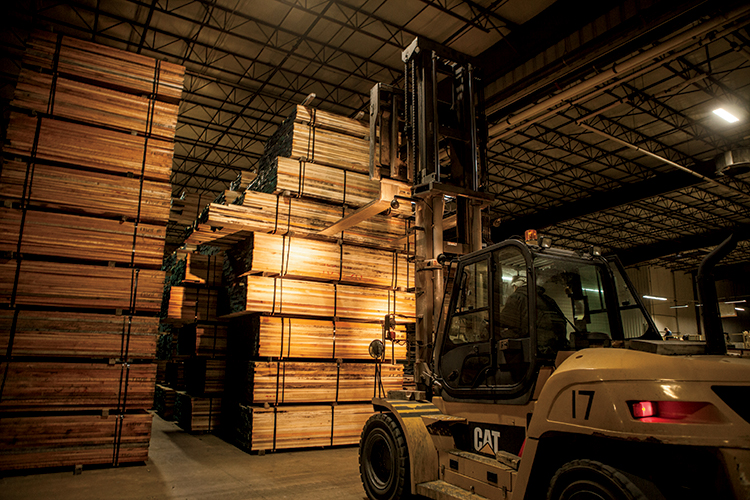Home > Indiana > Indiana Crops & Livestock > Indiana Hardwood Companies Are Crafting a Solid Industry
Indiana Hardwood Companies Are Crafting a Solid Industry
In partnership with: Indiana State Department of Agriculture

Indiana forests cover almost 800,000 more acres today than in 1950. These 4.87 million acres help fuel a hardwoods industry generating a statewide economic impact of more than $16 billion, benefiting a diverse hardwoods supply chain from wood product manufacturers to sawmills and loggers to private landowners.
Landowner to Manufacturer
Private landowners hold a high percentage of Indiana timberland (87 percent in 2013), and landowners received $164 million for the state’s timber harvested in 2010, according to a report by Purdue University’s William Hoover and Jeff Settle, Indiana DNR Division of Forestry Forest Resources Information.
“For every $1 paid to landowners for timber, $48 of value was added in the production of the final products,” Settle says.
Indiana’s final hardwoods products – worth $8 billion in 2010 – include wood stock-line kitchen cabinets, caskets and coffins, manufactured homes, plywood products and furniture.
The hardwoods industry adds another $8 billion to the state’s economy as timber is harvested, sawn, milled and used by wood products firms. That included $1.2 billion in total wages in 2010, with one-third paid to cabinet and office furniture manufacturing employees. Other hardwoods firms, ranging from loggers and sawmills to wooden window and door manufacturers, paid about $800 million in wages.

Global Growth
Cole Hardwood employs 170 people in Logansport, producing high-quality hardwood lumber to exact specifications required by global manufacturers.
“We buy lumber from sawmills all over Indiana, especially north of Highway 56,” says owner Milt Cole.
Cole’s sales have grown 10 to 15 times what they were when he purchased the company in 1986. The main reason: exports.
“I doubt there’s any state that has benefited as much as Indiana from the growth in global hardwoods demand,” he says. “Indiana produces a high-quality product that’s demanded all over the world.”
Cole Hardwood ships lumber from native Indiana hardwoods species – ash, basswood, beech, cherry, hickory, hard and soft maple, red and white oak, sassafras, and walnut.
Indiana hardwoods product exports – worth $254 million in 2009 – feature veneer, rough sawn planks, and furniture or furniture parts. The state’s total wood product exports (excluding furniture) increased 6 percent in 2013 and are approaching pre-recession levels.
Indiana furniture exports showed growth in high-value Middle Eastern and Asian markets, like Saudi Arabia and China, in 2013. Asian demand for hardwoods has changed the industry, Cole says.
“It once was that Asia would import our lumber, and it would come back [in finished goods] to compete with American products,” he says. “Now, we estimate 95 percent of our lumber stays in Asia, as consumers there have increased incomes.”
That helps increase the value of Indiana timber. A 2014 survey by the Indiana Woodland Steward Institute showed Indiana timber sales up 18 percent among respondents. Demand is especially strong for black walnut, white oak and hickory.
And the state’s forests are growing healthier. The Indiana State Forest Service reported 530,000 new forest acres between 1998 and 2013, which is more than the previous 40 years. Landowners enroll 600,000 acres in the Classified Forest Program, which helps monitor forest health and timber productivity.
“More and more Hoosier woodland owners see the value of working with professional foresters, who in turn help those landowners nurture their trees to maturity,” says Indiana State Forester John Seifert.
Those efforts pay off in both economic impact and forest health. In 2013, trees in Indiana’s forests grew three times more than the amount of timber removed in the state.
“Long-term forest management is beginning to pay dividends as the overall timber volume and quality continues to increase every year,” Seifert says. “This benefits Indiana companies that purchase those trees. A win-win for everyone.”



